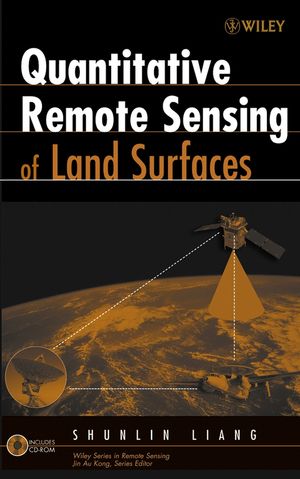Quantitative Remote Sensing of Land SurfacesISBN: 978-0-471-28166-5
Hardcover
560 pages
December 2003
 This is a Print-on-Demand title. It will be printed specifically to fill your order. Please allow an additional 15-20 days delivery time. The book is not returnable.
|
||||||
Acronyms.
Chapter 1. Introduction.
1.1 Quantitative Models in Optical remote Sensing.
1.2 Basic Concepts.
1.3 Remote Sensing Modeling System.
1.4 Summary.
1.5 References.
Chapter 2. Atmospheric Shortwave Radiative Transfer Modeling.
2.1 Radiative Transfer Equation.
2.2 Surface Statistical BRDF Models.
2.3 Atmospheric Optical Properties.
2.4 Solving Radiative Transfer Equations.
2.5 Approximate Representation for Incorporating Surface BRDF.
2.6 Summary.
2.7 References.
Chapter 3. Canopy Reflectance Modeling.
3.1 Canopy Radiative Transfer Formulation.
3.2 Leaf Optical Models.
3.3 Solving Radiative Transfer Equations.
3.4 Geometric Optical Models.
3.5 Computer Simulation Models.
3.6 Summary.
3.7 References.
Chapter 4. Soil and Snow Reflectance Modeling.
4.1 Single Scattering Properties of Snow and Soil.
4.2 Multiple Scattering Solutions for Angular Reflectance from Snow and Soil.
4.3 Geome tric Optical Modeling.
4.4 Inversion of Snow Parameters.
4.5 Practical Issues.
4.6 Summary.
4.7 References.
Chapter 5. Satellite Sensor Radiometric Calibration.
5.1 Background.
5.2 Post-launch Calibration Methods.
5.3 Calibration Coefficients for Landsat TM and AVHRR Reflective Bands.
5.4 Summary.
5.6 References.
Chapter 6. Atmospheric Correction.
6.1 Introduction.
6.2 Methods for Correcting Single Viewing-angle Imagery.
6.3 Methods for Correcting Multiangular Observations.
6.4 Methods for Estimating Total Column Water Vapor Content.
6.5 Summary.
6.6 References.
Chapter 7. Topographic Correction Methods.
7.1 Introduction.
7.2 Cosine Correction Algorithms.
7.3 IPW Method.
7.4 Shadowing Function Algorithms.
7.5 DEM Data and Generation.
7.6 Summary.
7.7 References.
Chapter 8. Estimation of Land Surface Biophysical variables.
8.1 Statistical Methods.
8.2 Optimization Inversion Method.
8.3 Generic Algorithm (GA).
8.4 Table Look-up Methods.
8.5 Hybrid Inversion Methods.
8.6 Comparisons of Different Inversion Methods.
8.7 Summary.
8.8 References.
Chapter 9. Estimation of Surface Radiation Budget: I. Broadband Albedo.
9.1 Introduction.
9.2 Broadband Albedo Characteristics.
9.3 Narrowband to Broadband Conversion.
9.4 Direct Estimation of Surface Broadband Albedos.
9.5 Diurnal Cycle Modeling.
9.6 Summary.
9.7 References.
Chapter 10. Estimation of Surface Radiation Budget (II): Longwave.
10.1 Introduction.
10.2 Monochromatic Radiative Transfer Formulation and Solutions.
10.3 Line-by-line Methods.
10.4 Band Models.
10.5 Correlated k-Distribution Methods.
10.6 Atmospheric Correction Methods.
10.7 Split-window Algorithm for Estimating LST.
10.8 Multispectral Algorithms for Separating Temperature and Emissivity.
10.9 Computing Broadband Emissivity.
10.10 Surface Energy Balance Modeling.
10.11 Summary.
10.12 References.
Chapter 11. Four-Dimensional (4D) Data Assimilation.
11.1 Introduction.
11.2 Assimilation Algorithms.
11.3 Minimization Algorithms.
11.4 Data Assimilation in Hydrology.
11.5 Data Assimilationdata with Crop Growth Models.
11.6 Summary.
11.7 References.
Chapter 12. Validation and Spatial Scaling.
12.1 Rationale of Validation.
12.2 Validation Methodology.
12.3 Spatial Scaling Techniques.
12.4 Summary.
12.5 References.
Chapter 13. Applications.
13.1 Methodologies for Integrating Remote Sensing with Ecological Process Models.
13.2 Agricultural Applications.
13.3 "Urban Heat Island" Effects.
13.4 Carbon Cycle Studies.
13.5 Land-atmospheric Interaction.
13.6 Summary.
References.
Appendix.
CD-ROM Content.
Data Directory
Software Directory.
Index.



